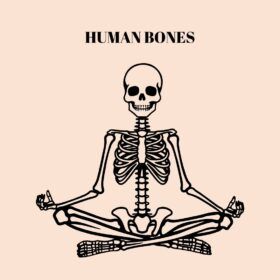
It would be lengthy to list each of the 206 human bones in the human body separately. I can give you a summary of the main bones, though, arranged according to the body regions they belong to:
This list of bones in the Human body , which is divided into regions, gives a general overview of the main bones in the human body. Each of these human bones is essential to the body’s structural integrity, organ protection, and ability to move and move about.
You can find these details in MBBS 1st year Books
Axial Skeleton (80 bones):
1. Skull:
* Frontal bone
* Parietal bones (2)
* Temporal bones (2)
* Occipital bone
* Sphenoid bone
* Ethmoid bone
* Maxilla (2)
* Zygomatic bones (2)
* Nasal bones (2)
* Lacrimal bones (2)
* Palatine bones (2)
* Inferior nasal conchae (2)
* Vomer
* Mandible
2. Hyoid bone
3. Vertebrae (26): Cervical, Thoracic, Lumbar, Sacrum, Coccyx
4. Ribs (24): True ribs (7 pairs), False ribs (3 pairs), Floating ribs (2 pairs)
5. Sternum
Appendicular Skeleton (126 bones):
Upper Extremities:
6. Clavicle (2)
7. Scapula (2)
8. Humerus (2)
9. Radius (2)
10. Ulna (2)
11. Carpals (16)
12. Metacarpals (10)
13. Phalanges (28)
Lower Extremities:
14. Coxal bones (2)
15. Femur (2)
16. Patella (2)
17. Tibia (2)
18. Fibula (2)
19. Tarsals (14)
20. Metatarsals (10)
21. Phalanges (28)
Vertebral Column (26 bones):
22. Cervical vertebrae (7)
23. Thoracic vertebrae (12)
24. Lumbar vertebrae (5)
25. Sacrum (1)
26. Coccyx (1)
Additional Bones:
27. Hyoid bone (1)
28. Sternum (1)
29. Mandible (1)
The skeletal system of humans is a sophisticated and multifaceted structure made up of many kinds of bones that cooperate to support and safeguard the body.
Every type of bone contributes to the general integrity and mobility of the human body in a different way, with a unique shape, structure, and function.
In addition to offering structural support, bones perform a host of vital tasks. They serve as a store for minerals that are essential for preserving the body’s mineral balance, such as calcium and phosphorus.
Furthermore, red and white blood cell formation occurs in bones, which is important for the body’s immunological response and oxygen transport.
The ability of bones to regenerate is one of their most amazing features. Remodelling is the process by which old bone tissue is continually broken down and replaced by new bone tissue throughout our lives.
Our bones have the amazing capacity to mend from fractures and adjust to the shifting demands made on them.
Taking care of our bones is essential for overall health and well-being. Adequate intake of calcium, vitamin D, and other essential nutrients is vital for promoting bone strength and density.
Engaging in weight-bearing exercises, such as walking and strength training, can help maintain bone density and reduce the risk of osteoporosis.
